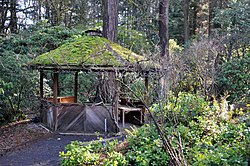| Berry Botanic Garden | |
|---|---|
 Gazebo in the woods | |
 | |
| Type | Botanical |
| Location | Portland, Oregon, United States |
| Coordinates | 45°26′33″N 122°39′43″W / 45.442380°N 122.661900°W |
| Area | 6.5 acres (26,000 m2) |
| Opened | 1930s |
| Operated by | The Friends of Berry Botanic Garden |
| Status | Closed |
| Collections | Primroses Alpine & subalpine Rhododendrons Pacific Northwest |
| Website | berrybot.org |
Rae Selling Berry Garden and House | |
 | |
| Built | 1939[1] |
| Architect | Reuben T. Sinex (house) and John Grant (landscape near house)[2] |
| NRHP reference No. | 02001637[1] |
| Added to NRHP | December 31, 2002[1] |
Berry Botanic Garden was a botanical garden in southwest Portland, Oregon, in the United States. In addition to large collections of alpine plants, rhododendrons, primulas, and lilies, it was known for its plant-conservation program and its large seed bank that protects rare or endangered plants of the Pacific Northwest. The seed bank, formally established in 1983, was thought to be the first in the U.S. that was devoted entirely to preserving rare native plants.
The garden, created in the 1930s by Portland resident Rae Selling Berry, was bought after her death in 1976 by The Friends of Berry Botanic Garden, a nonprofit corporation. Managed by a board of directors, the Berry estate had an area of 6.5 acres (26,000 m2), and contained the largest public rock garden on the West Coast.[3]
In January 2010, The Berry Botanic Garden Board of Directors announced plans to sell the property and close the garden because of funding problems. The property was sold in February 2011, and in November 2011 the BBG conservation program and seed bank, now known as the Rae Selling Berry Seed Bank & Plant Conservation Program, completed the transfer to the Environmental Science and Management Program at Portland State University.[4]
- ^ a b c "Oregon National Register List" (PDF). Oregon Parks and Recreation Department. June 6, 2011. p. 30. Archived from the original (PDF) on April 25, 2018. Retrieved August 7, 2023.
- ^ Cite error: The named reference
Historywas invoked but never defined (see the help page). - ^ Dresback, Rachel (2007). Insiders' Guide to Portland, Oregon, Including the Metro Area and Vancouver, Washington (5th ed.). Morris Book Publishing. pp. 137–38. ISBN 978-0-7627-4189-2. Retrieved January 23, 2010.
- ^ Pokorny, Kym (January 15, 2010). "Berry Botanic Garden reaches financial dead end". The Oregonian. Retrieved January 16, 2010.